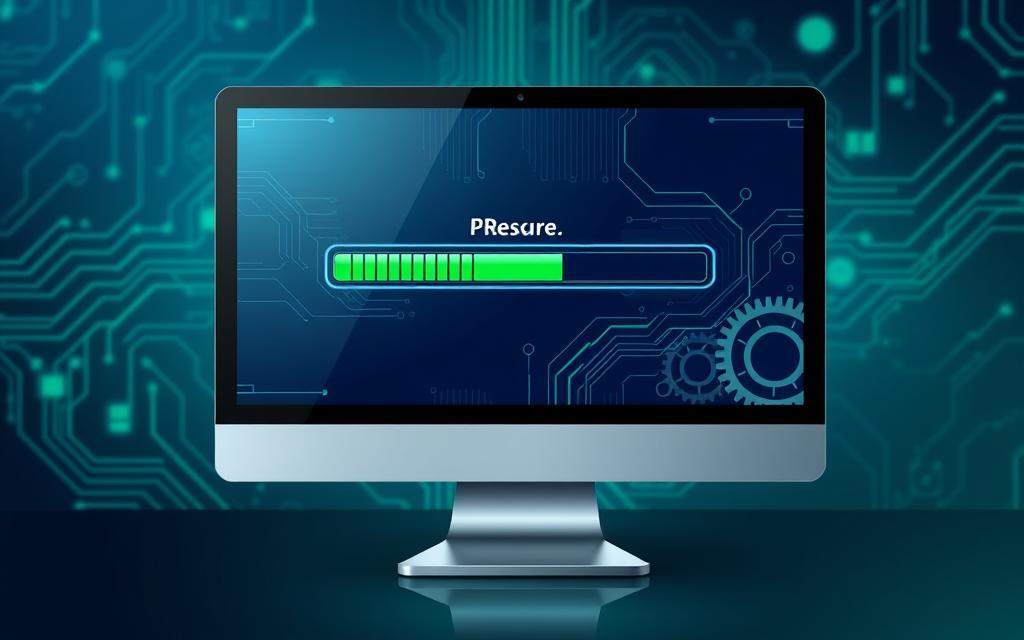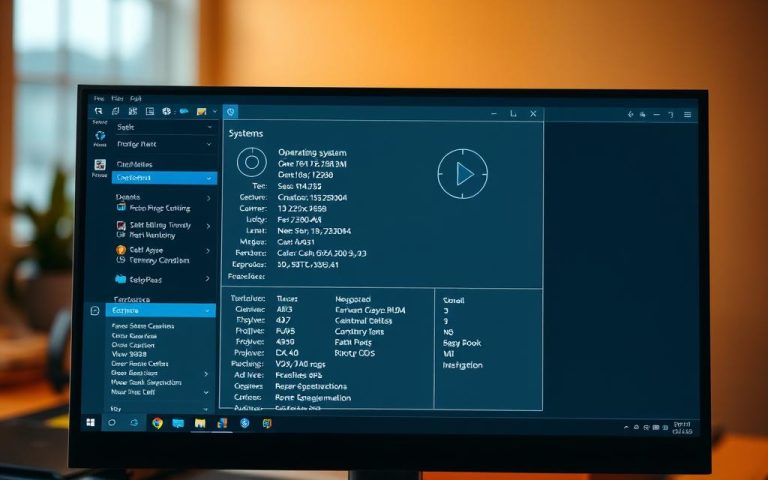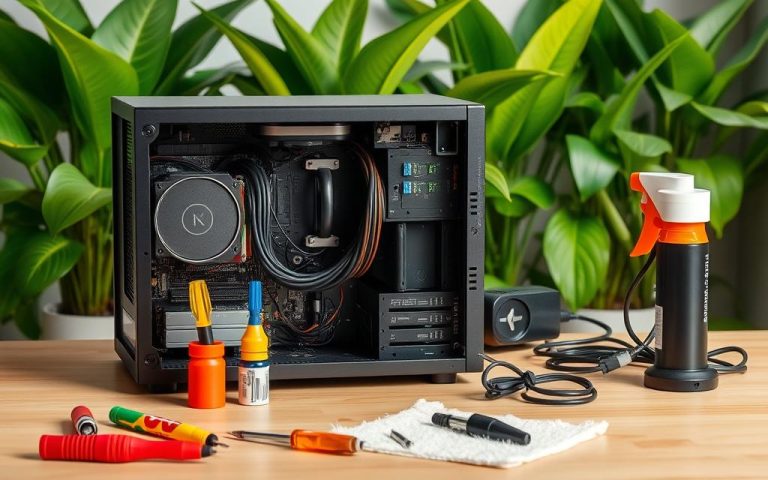How to Perform a System Restore on Your Computer: Step-by-Step Guide
System restore on your computer is easy with the right steps. This guide will show you how to get your computer back to health. Windows makes a restore point every week, which is great for going back to a previous version.
System restore is great for fixing problems caused by apps or updates. It can take your computer back to a good time. But remember, it doesn’t remove viruses or malware well. So, use a good virus scanner too.
System restore is on by default for the main drive (C:). But, you might need to turn it on for other drives. This guide will help you do system restore easily and keep your computer safe and fast. It’s perfect for fixing computer problems or learning about system restore.
Understanding System Restore: A Brief Overview
System restore lets users go back to a previous state on their computer. It’s useful for undoing changes made since the last restore point. This feature is found in Windows versions like Windows 11 and Windows 10.
Using system restore has many benefits. It helps undo changes and gets the computer back to a healthy state. Restore points are made automatically or by the user. They can be used to go back to a previous state.
Here are some key points about system restore:
- System restore is included in various Windows versions.
- System restore points are created automatically or manually.
- System restore points can be used to restore the computer to a previous state.
Understanding system restore is crucial. It helps undo changes and keeps the computer healthy. Knowing how to use system restore can make your computer run smoothly.
| Windows Version | System Restore Availability |
|---|---|
| Windows 11 | Available |
| Windows 10 | Available |
| Windows 8 | Available |
| Windows 7 | Available |
| Windows Vista | Available |
| Windows XP | Available |
When Should You Use System Restore
System restore is a key feature that keeps your computer safe from sudden crashes and problems. It’s useful when your computer has issues or gets malware. This tool lets you go back to a time when everything was working well.
Here are some times you might need to use system restore:
- After a system update or driver installation that caused system instability
- When your computer is infected with malware
- After installing a new software program that caused system crashes
Remember, system restore doesn’t touch your personal files or apps. It only changes system settings to keep things running smoothly. Microsoft System Restore is a great tool for fixing system errors and keeping Windows 11 healthy.
Using system restore can save you time and prevent system damage. It’s a good idea to turn on system restore protection for your system drive. Also, make restore points before making big changes to your system.
| Scenario | Use System Restore |
|---|---|
| System instability after update | Yes |
| Malware infection | Yes |
| System crash after software installation | Yes |
Preparing Your Computer for System Restore
To make sure your system restore goes smoothly, prepare your computer first. This means taking a few easy steps to protect your data and settings. Backup is key, as it helps you get back your important files if something goes wrong.
It’s important to check your restore points. Windows makes these points automatically, but you can also make them yourself. By looking at your restore points, you can pick the right one for your system restore. This way, you can go back to a time when your computer was working well.
Also, make sure your computer has enough power for the restore. You’ll need enough space on your disk and memory. By doing this, you make sure your computer is ready for the restore. This reduces the chance of problems or losing data.
- Regularly backing up important files to an external drive or cloud storage
- Checking available restore points to determine the best one to use
- Ensuring sufficient system resources, such as disk space and memory
By following these steps and being careful, you can have a successful system restore. This way, you avoid errors or losing data.
How Do I Do System Restore on My Computer: The Basic Process
To do a system restore, you need to know the basic steps. First, you access the system restore settings through the Control Panel. Then, you pick a restore point from the list. Make sure it’s before the problem started to get back to a stable state.
The system restore is easy but needs careful thought. To choose a restore point, follow these steps:
- Open the Control Panel and click on the System and Security option.
- Click on the System option and then click on the System Protection option.
- Click on the System Restore button and select the restore point you want to use.
After picking a restore point, you must confirm it. This step is key to ensure the system goes back to the right state. Remember, the system restore can’t be stopped once it starts. So, double-check your choice before you begin.

It’s also vital to understand how system restore works. It creates a snapshot of system files and registry. This snapshot is used to take the system back to a previous state. This process is usually automatic but can be done manually through the Control Panel.
Different Ways to Access System Restore
There are many ways to get to system restore, fitting all sorts of users. One popular way is through the Control Panel. Here, you go to System and Security and then System.
Another option is using keyboard shortcuts or the Windows Recovery Environment. For example, pressing the Windows key + S opens the search box. Type “create a restore point” to get to System Properties. Then, click System Restore to start.
The guide on 7 ways to access System Restore in Windows shows many paths. You can use the Command Prompt, Task Manager, or Safe Mode with Command Prompt. Each step is clearly explained.
System restore has its perks. It lets you make manual restore points and auto-creates them before big system changes. But remember, it doesn’t save old files and can’t remove viruses or malware.
Knowing the different access methods helps users pick the best one. This way, they can use system restore to keep their system safe and stable.
Creating Manual Restore Points
Creating manual restore points is key to keeping your system stable and data safe. It acts as a backup, letting you go back to a previous state if problems arise.
Windows saves restore points automatically if system protection is on. You can also set how much disk space is used for these points. It’s wise to use a small part of your hard drive for this, like less than 10%.
Setting Up Automatic Restore Points
In Windows 10, you can turn on automatic system restore points. These are made before big changes like Windows updates or new software installs. It’s also good to make a manual restore point now and then to prevent data loss from unexpected errors.
Managing Restore Point Storage
To save space, you can delete all restore points for a drive. It’s important to check and manage these points often to make room for new ones. Tools like EaseUS Todo Backup Home can help manage restore points. They offer backup, recovery, and cloning of your Windows system.
By following these steps and using the right tools, you can create and manage restore points well. This keeps your system and data safe from any problems.
System Restore in Safe Mode
When a computer has severe problems, like a virus or system crashes, system restore in safe mode can help. It can fix issues that stop the computer from starting up right.
To get into safe mode, you can press F8 during startup or use the Settings option. About 40-45% of users pick the Settings option, and 30-35% choose the Command Prompt.
Benefits of Using System Restore in Safe Mode
System restore in safe mode has many advantages. It can take your computer back to a time when it worked well. This is great for fixing problems caused by new software or drivers.
Important things to remember when using system restore in safe mode include:
- System restore keeps your files safe but might need you to reinstall programs you added later.
- The restore process takes about 20 minutes and might need you to reboot a few times.
- Always back up your important files before doing a system restore.
By following these steps and using system restore in safe mode, you can fix system problems and get your computer working well again.
| Method | Percentage of Users |
|---|---|
| Settings option | 40-45% |
| Command Prompt method | 30-35% |
| Other methods | 25-30% |
Troubleshooting Common System Restore Issues
System Restore can sometimes get stuck or not work right. Troubleshooting is key to solving these problems. Issues like System Restore failing can happen for many reasons. These include damaged system files, malware, or interference from antivirus software.
To fix System Restore problems, check the System Properties settings. Make sure the Volume Shadow Copy Service (VSS) is working well. Also, upping the disk space for restore points can prevent failures. It’s best to set it to over 5 percent, not the default 3 percent.
When System Restore fails, you might see error messages like “System Restore failed” or “A shadow copy could not be created.” You might also see error codes like 0x80070005, 0x800423F3, or 0x80070570. Try running System Restore in Safe Mode. You can also use the System File Checker tool or try EaseUS Todo Backup.

- Run System Restore in Safe Mode
- Check System Properties settings
- Repair corrupted system files using the System File Checker tool
- Use alternative system restore software such as EaseUS Todo Backup
By following these steps, you can fix common System Restore problems. This ensures your system is back to normal. If these steps don’t work, you might need to reinstall Windows. But, this should be a last resort. With the right troubleshooting methods and tools, you can overcome System Restore failures and keep your system running smoothly.
| Common Error Messages | Causes | Solutions |
|---|---|---|
| System Restore failed | Corrupted system files, malware infections | Run System Restore in Safe Mode, check for corrupted system files |
| A shadow copy could not be created | Interference from third-party antivirus software | Disable third-party antivirus software, increase disk space allocation |
| Error codes: 0x80070005, 0x800423F3, 0x80070570 | Corrupted system files, malware infections | Run System Restore in Safe Mode, check for corrupted system files, use alternative system restore software |
System Restore for Different Windows Versions
System restore is a key feature in Windows. It lets users go back to a previous state if problems occur. The steps to use system restore differ between various Windows versions.
For system restore, Windows 10 and Windows 11 have unique options. For example, Windows 10 offers Reset this PC, Go back to an earlier build, and Advanced startup.
Windows 10 Specific Features
In Windows 10, system restore saves files automatically each week. It also does so before major updates to help with performance issues after updates.
Windows 11 Considerations
Windows 11 also has special features for system restore. It can restore a complete system image, boot in Safe Mode, and fix startup problems with Startup Repair.
Here are some key features of system restore in different windows versions:
- Windows 10: Reset this PC, Go back to an earlier build, Advanced startup
- Windows 11: Restore complete system image, Safe Mode, Startup Repair
Understanding system restore for different Windows versions helps users fix system issues. It’s a powerful tool for troubleshooting.
| Windows Version | System Restore Features |
|---|---|
| Windows 10 | Reset this PC, Go back to an earlier build, Advanced startup |
| Windows 11 | Restore complete system image, Safe Mode, Startup Repair |
Alternatives to System Restore
Looking for alternatives to system restore? There are a few options that work well. Recovery drive options and system image backup are two of them. They help you restore your system or make a full backup of your hard drive.
A recovery drive is a USB with system files and drivers. It’s great for fixing unbootable systems. System image backup, on the other hand, makes a full copy of your hard drive. It includes all your system files, settings, and personal data.
Recovery Drive Options
Recovery drive options are found in software like MiniTool ShadowMaker and EaseUS Todo Backup. These tools help you make a recovery drive. MiniTool ShadowMaker, for example, backs up your system drive fully. This includes system partition, system reserved partition, and EFI system partition.
System Image Backup
System image backup is another choice. It makes a full backup of your hard drive. This backup can restore your system to a previous state. System Image Recovery uses a system image, saved on an external hard drive or DVD. It’s best for a full hard drive backup.

In summary, alternatives like recovery drive options and system image backup offer ways to restore your system or make a full backup. Exploring these options helps protect your system. It ensures you can easily restore it if needed.
Best Practices for System Maintenance
Regular system maintenance is key to a computer’s smooth operation. Tasks like disk cleanup, defragmentation, and updates are crucial. With about 50% of machines nearing 5 years old, maintenance is vital to avoid problems.
Using tools like the System File Checker (sfc) can keep the operating system healthy. It scans and replaces system files.
Removing unused programs and updates is another best practice. It frees up space and boosts performance. Tools like System Restore can also restore the system to a previous state if needed.
Other practices include uninstalling old programs and stopping unnecessary startup programs. Using Auslogics disk defrag for disk defragmentation is also beneficial. For older machines, consider re-imaging or using VDI to extend their life and improve management.
By adopting these practices, users can keep their computers in top shape. It’s wise to use automated tools for updates and consider Ninite Pro for software updates.
| Tool | Description |
|---|---|
| System File Checker | Scans and replaces system files |
| Auslogics disk defrag | Defragments the disk to improve performance |
| Ninite Pro | Automates software updates |
Conclusion
In today’s fast-changing digital world, system restore is a key tool for keeping your computer safe. It helps Windows users deal with sudden system problems by going back to a stable point. This guide has shown you how to use it, from the basics to fixing common issues.
System restore is great for solving software issues, driver problems, or system crashes. It lets you go back to a working state quickly, saving your data and keeping things smooth. You can also use it in Safe Mode, making it even more useful.
Now you know how to keep your computer healthy. Use system restore to make your computing safer and more reliable. With what you’ve learned, you can protect your system, avoid problems, and enjoy a smooth experience.
FAQ
What is System Restore?
System Restore is a feature in Microsoft Windows. It lets users go back to a previous state. This can undo changes made to the system.
How do System Restore points work?
Windows creates restore points at key system events, like installing new software. Users can also make their own restore points. These points capture the computer’s state, allowing it to be restored if needed.
What are the benefits of using System Restore?
System Restore’s main benefits are undoing changes and restoring the computer to a healthy state. It helps fix issues caused by software or system changes.
When should I use System Restore?
Use System Restore when your computer has problems. This includes software conflicts or malware. It’s a useful tool for troubleshooting.
How do I prepare my computer for System Restore?
Before using System Restore, back up important files. Check the restore points available. Make sure your computer has enough resources to restore.
What are the steps to perform a System Restore?
To perform a System Restore, access the System Restore settings. Choose a restore point and confirm to start the process.
How can I access System Restore?
You can access System Restore through the Control Panel, keyboard shortcuts, or the Windows Recovery Environment. The best method depends on your situation.
How do I create manual restore points?
Users can create manual restore points in addition to Windows’ automatic ones. This captures the system’s state at a specific time. It’s useful for troubleshooting or before big changes.
When should I use System Restore in Safe Mode?
System Restore is especially useful in Safe Mode. Safe Mode loads a basic Windows version. It’s helpful when the computer won’t boot normally.
What are some common System Restore issues and how can I troubleshoot them?
Common issues include failed restore points or compatibility problems. Troubleshooting involves finding the cause and using System Restore to fix it.
How does System Restore work on different Windows versions?
System Restore is available in most Windows versions. However, Windows 10 and Windows 11 have different implementations. Users should know how to use it for their version.
What are some alternatives to System Restore?
Besides System Restore, there are other ways to recover or restore a computer. Options include using a recovery drive or creating a system image backup. These alternatives offer flexibility or extra functionality.
What are some best practices for system maintenance?
Keeping software and drivers updated, backing up regularly, and using tools like System Restore are key. These practices prevent issues and keep your computer running smoothly.















